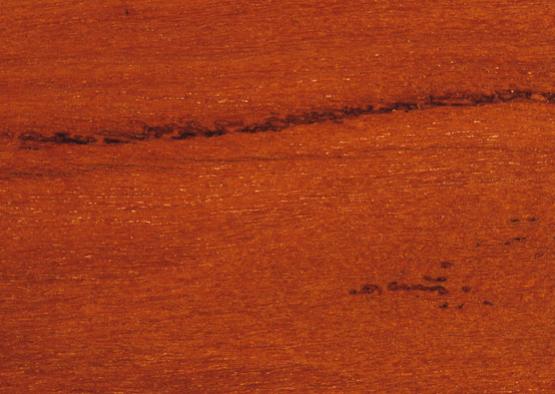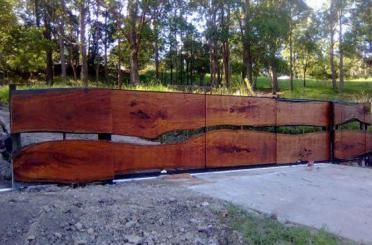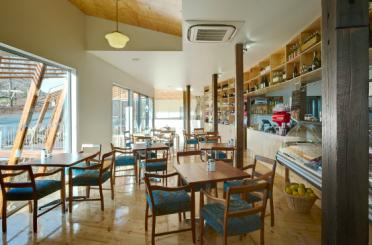Red bloodwood is a medium-sized Australian hardwood occurring along the coast of New South Wales and Queensland. It is commonly used in the production of round timber.
Bloodwood, Pale Bloodwood, Pink Bloodwood, Pale Kulcha Bloodwood, Small-flowered Bloodwood, Eucalyptus gummifera, Eucalyptus corymbosa, Corymbia intermedia, Eucalyptus intermedia, Corymbia polycarpa, Eucalyptus polycarpa
Corymbia gummifera

Taking its common name from the appearance of its heartwood, red bloodwood ranges from a dark pink to dark red colour, with much paler sapwood. It has a course texture, with the grain usually interlocked.
Due to the presence of concentric gum veins, red bloodwood is not ideally suited for use as sawn timber as gum veins - or the red-coloured kino veins - can open up during drying. This species is mainly used for round timber applications such as poles, piles and posts, however due to its attractive grain pattern, red bloodwood is also used for veneers and decorative paneling.
Red bloodwood can be painted, stained and polished. It glues satisfactorily, but any surface preparation or machining should be done so immediately prior.
A highly durable and dense species, red bloodwood is well suited for in-ground applications such as posts, although untreated sapwood is susceptible to lyctid attack.
Red bloodwood is generally readily available, especially close to the areas it grows.
Shrinkage
| Very Low | Low | Medium | High | Very High | |
|---|---|---|---|---|---|

|

|
||||
Tangential : |
3.30%
|
||||
Radial : |
2.50%
|
||||
Unit Movement Tangential: |
0.33%
|
||||
Unit Movement Radial: |
0.25%
|
Strength Group

Very High |
High |
Reasonably High |
Medium High |
Medium |
Reasonably Low |
Low |
Very Low |
||
Unseasoned: |
S1 |
S2 |
S3 |
S4 |
S5 |
S6 |
S7 |
S8 |
|
|---|---|---|---|---|---|---|---|---|---|
 |
|||||||||
Seasoned: |
SD1 |
SD2 |
SD3 |
SD4 |
SD5 |
SD6 |
SD7 |
SD8 |
|
 |
Stress Grade

| Structural No. 1 |
Structural No. 2 |
Structural No. 3 |
Structural No. 4 |
Structural No. 5 |
|
Unseasoned: |
F17 |
F14 |
F11 |
F8 |
F7 |
Seasoned: |
F27 |
F22 |
F17 |
F14 |
F11 |
Density per Standard

Seasoned: |
1005kg/m3
|
|---|---|
Unseasoned: |
1140kg/m3
|
Joint Group

Very High |
High |
Reasonably High |
Medium |
Low |
Very Low |
|
Unseasoned: |
J1 |
J2 |
J3 |
J4 |
J5 |
J6 |
|---|---|---|---|---|---|---|
 |
||||||
Seasoned: |
JD1 |
JD2 |
JD3 |
JD4 |
JD5 |
JD6 |
 |
Colour

| White, yellow, pale straw to light brown | Pink to pink brown | Light to dark red | Brown, chocolate, mottled or streaky | |
 |
||||
Mechanical Properties
Modulus of Rupture - Unseasoned: |
114
|
|---|---|
Modulus of Rupture - Seasoned: |
122
|
Modulus of Elasticity - Unseasoned: |
|
Modulus of Elasticity - Seasoned: |
22
|
Maximum Crushing Strength - Unseasoned:  |
56
|
Maximum Crushing Strength - Seasoned: |
79
|
Impact - Unseasoned: |
|
Impact - Seasoned: |
|
Toughness - Unseasoned: |
Medium - 15 - 24 Nm
|
Toughness - Seasoned: |
Medium - 15 - 24 Nm
|
Hardness - Unseasoned: |
8.6
|
Hardness - Seasoned: |
9.4
|
Durability
| Low | Moderate | Reasonably High | High | |
| (0 - 5 yrs) | (5 - 15 yrs) | (15 - 25 yrs) | (more than 25 yrs) | |
In-Ground: |
 |
|||
| (0 - 7 yrs) | (7 - 15 yrs) | (15 - 40 yrs) | (More than 40 yrs) | |
Above ground: |
 |
|||
| (0 - 20 yrs, usually < 5) | (21 - 40 yrs) | (41 - 64 yrs) | (More than 60 yrs) | |
Marine Borer Resistance: |
 |
Lyctid Borer Susceptibility: |
Susceptible |
|---|---|
Lyctid Borer Susceptibility - Other: |
|
Termite Resistance: |
Resistant
|
Fire Properties
| 0 | 1 | 2 | 3 | 4 | 5 | 6 | 7 | 8 | 9 | 10 | |
EFH Spread-of-Flame Index: |
|||||||||||
EFH Smoke-Developed Index: |
Critical Radiance Flux - Lower: |
>2.2 and <4.5 |
|---|---|
Critical Radiance Flux - Higher: |
≥4.5 |
Smoke Development Rate: |
<750
|
| 1 - non-combustible | 2 - reasonably non-combustible | 3 - slightly combustible | 4 - combustible | |
Fire Properties Group |
Average Specific Extinction Area: |
<250
|
|---|---|
Bushfire Resistance: |
BAL 12.5 and 19 – All AS3959 required applications
|
Red bloodwood ranges from a dark pink to dark red colour, with a much paler sapwood. It has a course texture, with the grain of red bloodwood usually interlocked.
Concentric gum veins, or kino veins, feature prominently and make this an attractive feature for decorative veneers and paneling.
While the presence of concentric gum veins is an attractive feature for decorative veneers and paneling, this also limits the other applications of red bloodwood to round timber. Poles, piles and posts are the most common and red bloodwood's high durability makes it well suited for in-ground applications. Red bloodwood can also be used for sleepers, fencing and house stumps.
Red bloodwood can be painted, stained and polished. It glues satisfactorily, but any surface preparation or machining should be done so immediately prior.
The presence of concentric gum veins means red bloodwood is rarely used in sawn timber form - mainly round timber and decorative veneers or paneling.
Red bloodwood can be seasoned satisfactorily, however there is a tendency for the gum veins to open up during the drying process.

Fencing

Structural Timber Poles
Allied Forest Products

Australian Solar Timbers

BAYWOOD

Outlast Timber Supplies




